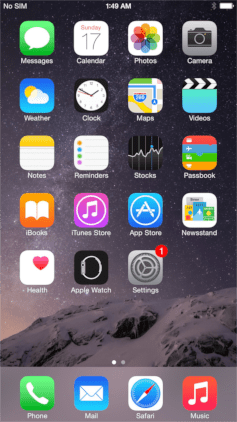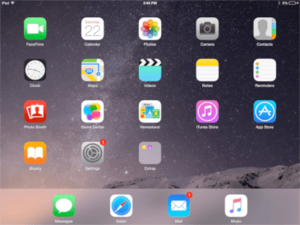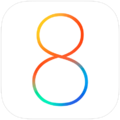IOS 8 facts for kids
| Version of the iOS operating system | |
 |
|

iOS 8.2 home screen on an iPhone 6 Plus
|
|
| Developer | Apple Inc. |
|---|---|
| Source model | Closed, with open source components |
| Initial release | September 17, 2014 |
| Latest release | 8.4.1 (12H321) / August 13, 2015 |
| Repository |
|
| Update method | Software Update |
| Package manager | App Store |
| Platforms | iPhone, iPod Touch, iPad |
| Kernel type | Hybrid (XNU) |
| License | Proprietary EULA except for free software components |
| Preceded by | iOS 7 |
| Succeeded by | iOS 9 |
| Tagline | The biggest iOS release ever. |
| Support status | |
| Obsolete, unsupported. No longer receiving security updates, as all iPhones, iPads, and iPod Touches that support iOS 8 also support iOS 9. Drops support for the iPhone 4. | |
iOS 8 was a big update for Apple's iOS mobile operating system. It came after iOS 7 and was replaced by iOS 9. Apple first showed iOS 8 on June 2, 2014, at their Worldwide Developers Conference. It was officially released to everyone on September 17, 2014.
This version brought many new features to iPhones, iPads, and iPod Touches. It made it easier for different apps to work together and for Apple devices to connect with each other. For example, you could start writing an email on your iPhone and finish it on your iPad or Mac. There were also updates to the keyboard, a new health app, and better ways to share things with your family.
People generally liked iOS 8. They especially praised how apps and devices could work together more smoothly. The new keyboard, which suggested words as you typed, was also a hit. However, some people noted that it would take time for app makers to use all the new features.
About a week after it came out, nearly half of all iOS devices were running iOS 8. But then, its growth slowed down. This was because the update needed a lot of free space to install, which was hard for older iPhones with less storage. By December 2014, more devices had updated, reaching 63% usage.
Contents
- History
- Cool New Features
- App Updates
- Photos and Camera: Better Pictures and Editing
- Messages: Group Chats and Voice Clips
- Safari: Safer Browsing
- iCloud Drive: Your Files, Everywhere
- App Store: Easier to Find Apps
- Health: Your Fitness and Medical Info
- HomeKit: Smart Home Control
- Passbook: Introducing Apple Pay
- Music: Apple Music Arrives
- Notes: Richer Notes
- Tips: Learn About Your iPhone
- Touch ID: Use Your Fingerprint in Apps
- Problems and Fixes
- Hoaxes
- Supported Devices
- Images for kids
- See also
History
How iOS 8 Was Introduced
Apple first showed off iOS 8 at their Worldwide Developers Conference on June 2, 2014. This is a big event where Apple shares its latest software and plans. After the main presentation, a test version of iOS 8 was given to developers.
The official version of iOS 8 was released to the public on September 17, 2014.

Cool New Features
Continuity: Your Devices Working Together
iOS 8 introduced a feature called Continuity. This made your Apple devices like your Mac, iPhone, and iPad work together better than ever. For example, you could answer phone calls or reply to text messages right from your iPad or Mac, even if your iPhone was in another room.
Continuity also had a cool feature called Handoff. This let you start something on one device and easily continue it on another. Imagine starting an email on your iPhone, then picking up your iPad to finish it, and finally sending it from your Mac! For this to work, Macs needed to be updated to OS X Yosemite.
Spotlight: Super Smart Search
Spotlight got a big upgrade in iOS 8. It became a much smarter search tool. When you searched for something, it didn't just look at your device. It also showed results from Wikipedia, local news, apps you had, iTunes, movie times, and even places nearby. You could find Spotlight search on your home screen and in the Safari web browser.
Notifications: Quick Actions and Widgets
The Notification Center was redesigned. It now allowed widgets, which are small parts of apps that show you information without opening the full app. For example, a weather widget could show you the current temperature. You could add, move, or remove these widgets whenever you wanted.
Notifications also became actionable. This meant you could reply to a message right from the notification that popped up, without having to open the Messages app.
Keyboard: Smarter Typing
iOS 8 included a new feature for the keyboard called QuickType. This feature showed you word suggestions above the keyboard as you typed, helping you write faster and more accurately.
Apple also allowed other companies to create their own keyboard apps. This meant you could download and use a different keyboard if you didn't like the default one.
Family Sharing: Easy Sharing for Families
Family Sharing was a new way for up to six family members to share apps, music, movies, and books. One parent could be the organizer and control what younger kids could buy. For example, if a child wanted to buy an app, the parent would get a request to approve it first.
Family Sharing also created a shared photo album where everyone could add pictures and videos.
Multitasking: See Recent Contacts
When you opened the multitasking screen (by double-tapping the home button), you would see a list of your most recent and favorite contacts. This made it quicker to call or message people you talked to often.
Other System Updates
- Siri could now identify songs playing around you using Shazam. Just ask, "What song is this?"
- Wi-Fi calling was added, letting you make phone calls over a Wi-Fi network instead of using your cellular signal.
App Updates
Photos and Camera: Better Pictures and Editing
Camera App Improvements
The Camera app got two new features: time-lapse and self-timer. Time-lapse lets you record events that happen slowly, like a sunset, and then play them back quickly. The self-timer gave you a 3 or 10-second countdown before taking a photo. iPads could also take panoramic photos.
iCloud Photo Library: Photos in the Cloud
iOS 8 added iCloud Photo Library. This feature automatically saved all your photos and videos in their original quality to iCloud. This meant your photos were safe and you could see them on all your Apple devices. It also helped save space on your device by storing smaller versions of photos there.
Smarter Photo Search and Editing
The Photos app got better search options, letting you find pictures based on where they were taken, when they were taken, or if they were marked as favorites. You also had more precise editing tools to adjust brightness, contrast, and colors.
Camera Roll Returns
When iOS 8 first came out, Apple removed the "Camera Roll" album, which showed all your photos. This caused many users to complain. So, Apple brought the Camera Roll back in the iOS 8.1 update!
Messages: Group Chats and Voice Clips
The Messages app got new features for group conversations. You could mute notifications for a group chat or even remove people from it. A new "Tap to Talk" button let you quickly send voice messages, and you could also record short videos to send. Messages could also be set to automatically delete after a certain time.
Safari: Safer Browsing
The Safari web browser added support for sharing passwords between websites and apps from the same company. This meant you wouldn't have to type your login details as often.
iCloud Drive: Your Files, Everywhere
iCloud Drive was introduced as a place to store any kind of file in the cloud. Once turned on, you could save documents, presentations, or other files, and they would sync across all your Apple devices. It worked like a simple file manager.
App Store: Easier to Find Apps
The App Store was updated to make it easier to discover new apps. It had an "Explore" tab and showed trending searches. Developers could also create "app bundles," letting you buy several apps together at a discount. You could also watch short "preview" videos to see how an app worked before downloading it.
Health: Your Fitness and Medical Info
The new Health app could gather data from different fitness apps you used. It also had a "Medical ID" section where you could store important health information, like allergies or emergency contacts. This Medical ID could be accessed from your lock screen in an emergency.
HomeKit: Smart Home Control
HomeKit was a new system that let you control smart home devices (like smart lights or thermostats) using your iPhone. You could set up different "rooms" and "scenes" to control multiple devices at once, even using Siri with your voice.
Passbook: Introducing Apple Pay
The Passbook app (now called Wallet) was updated to support Apple Pay. This new digital payment service allowed iPhone 6 and 6 Plus users to pay for things in stores using their phone. Apple Pay was released with the iOS 8.1 update.
Music: Apple Music Arrives
In the iOS 8.4 update, Apple introduced Apple Music, a new music streaming service. With a subscription, you could listen to millions of songs on demand. The Music app was redesigned to include Apple Music and a 24-hour live radio station called Apple Music 1.
Notes: Richer Notes
The Notes app got new features like the ability to make text bold, italic, or underlined. You could also add images to your notes.
Tips: Learn About Your iPhone
iOS 8 added a new app called Tips. This app would show you helpful tips and information about different features in iOS each week.
Touch ID: Use Your Fingerprint in Apps
With iOS 8, you could now use Touch ID (your fingerprint) to log into or approve things within other apps, not just to unlock your phone or buy from Apple.
Problems and Fixes
Update Issues
Shortly after iOS 8 was released, an update called iOS 8.0.1 caused some problems for iPhone 6 users. It temporarily disabled Touch ID and cellular service on some phones. Apple quickly released iOS 8.0.2 the next day to fix these issues.
The "Effective Power" Text Message Bug
In May 2015, a strange bug was discovered. Receiving a text message with a specific combination of symbols and Arabic characters could cause the Messages app to crash and the iPhone to restart. If the message appeared on the lock screen, it could even make the phone restart over and over! This bug was fixed in the iOS 8.4 update.
Hoaxes
"Apple Wave" Microwave Charging Hoax
In September 2014, a fake advertisement for iOS 8 spread online. It claimed that a new feature called "Wave" would let you recharge your iPhone by heating it in a microwave oven. This was a dangerous hoax, and many people unfortunately damaged their iPhones by trying it. The fake ad originally came from a website called 4chan.
Supported Devices
iOS 8 worked on devices that had an Apple A5 chip or newer. This meant that the iPhone 4 was no longer supported.
iPhone |
iPod Touch
|
iPad
|
Images for kids
See also
 In Spanish: IOS 8 para niños
In Spanish: IOS 8 para niños



